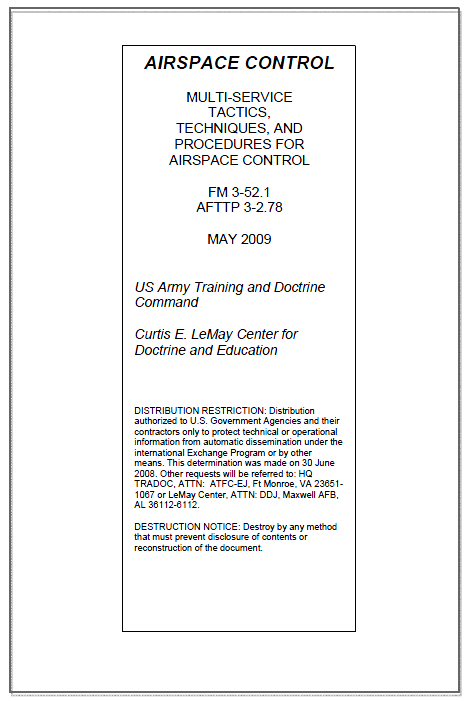MULTI-SERVICE TACTICS, TECHNIQUES, AND PROCEDURES FOR AIRSPACE CONTROL
- 118 pages
- May 2009
This multi-Service tactics, techniques, and procedures (MTTP) publication facilitates multi-Service coordination, integration, and regulation of airspace during exercises and operations where more than one Service shares airspace for operational use.
2. Scope
This MTTP publication is a tactical-level document to synchronize and integrate airspace command and control functions and serves as a single source reference for planners and commanders at all levels. It synchronizes airspace control roles and responsibilities within the campaign plan while unifying individual Service doctrine and TTP for airspace control planning and execution. In addition, it provides planning, assignment, execution, and transition procedures to address specific complex and unique airspace coordinating measures. This publication also outlines enabling information and communications interfaces necessary to establish integrated airspace control.
…
1. Introduction
a. Combat operations require effective airspace control in the combat zone. The proliferation of unmanned aircraft systems (UASs) and the fielding of indirect fire platforms capable of higher altitudes and greater ranges create additional demands and complexities on the airspace control process. In addition to military airspace users, current and future operational environments may include civilian airliners, nongovernmental organizations (NGOs), and relief agencies, especially during stability operations. These increased user demands require an integrated airspace control system to enable mission accomplishment and minimize risk.
b. Integration and synchronization of all airspace users is required to establish the unity of effort necessary for effective combat operations. Historically, the primary method of airspace control and deconfliction has been to reserve airspace for each user and then ensure they remained within their assigned airspace. This method is time consuming and not responsive enough to support current dynamic operations, forcing commanders to accept risk for airspace users, operations, or both. With the proliferation of airspace users in a congested space, there may not be enough airspace to effectively divide, separate, or partition areas for deconflicted operations.
2. Establishing Airspace Control
a. Joint Publication (JP) 3-52, Joint Doctrine for Airspace Control in a Combat Zone, defines airspace control in the combat zone as “a process used to increase combat effectiveness by promoting the safe, efficient, and flexible use of airspace. Airspace control is provided to reduce the risk of friendly fire, enhance air defense operations, and permit greater flexibility of operations.”
b. Airspace control procedures within the joint operations area (JOA) are approved by the joint force commander (JFC) and are derived entirely from the JFC’s authority. Commanders should adhere to JFC guidance on airspace coordinating measures (ACMs) so as not to exceed the JFC’s acceptable level of risk. Effective airspace control should maximize combat effectiveness without unduly restricting combat operations. In accordance with the JFC’s guidance (i.e., airspace control plan [ACP]), airspace control agencies direct the maneuver of aircraft and integrate fires for the best use of assigned airspace. “Airspace control does not infringe on the authority vested in commanders to approve, disapprove, or deny combat operations.” (JP 3-52)
c. Airspace is inherently joint. Any action taken by an airspace user may impact other airspace users. The airspace control authority (ACA) delegates authority to control airspace to elements of the theater air ground system (TAGS). The ACA establishes an airspace control system (ACS) responsive to the needs of the JFC and integrated with the host nation (HN). “The ACS is an arrangement of those organizations, personnel, policies, procedures, and facilities required to perform airspace control functions. Airspace control should be executed through a responsive theater/tactical air control system capable of real time control that includes surface and airborne assets, as necessary (e.g., CRC and AWACS). The ACS requires timely exchange of information through reliable, secure, and interoperable communications networks. Elements of the ACS may have dual-roles as DCA assets (e.g., a CRC can be a SADC).” (JP 3-01)
d. The definition of coordinating altitude in JP 3-52 is “a procedural airspace control method to separate fixed- and rotary-wing aircraft by determining an altitude below which fixed-wing aircraft will normally not fly and above which rotary-wing aircraft normally will not fly.” Current Operation Iraqi Freedom (OIF)/Operation Enduring Freedom (OEF) operations use the term “coordinating altitude” as the vertical limit between airspace controlling agencies [i.e., the top of Army controlled airspace and the bottom of control and reporting center (CRC) controlled airspace]. The current theater usage is outside the JP 3-52 doctrinal definition.
e. The use of ACMs (e.g., high-density airspace control zone [HIDACZ], restricted operations zone [ROZ] usages or sectors) to employ lateral, horizontal, and vertical limits between airspace controlling agencies should be the preferred method of assigning airspace control responsibilities.

